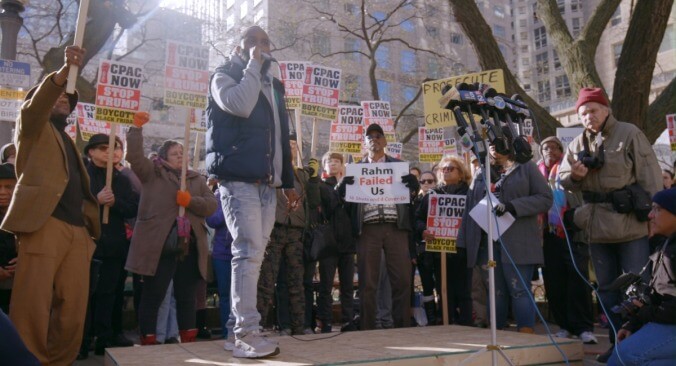16 Shots tells a tale of two Chicagos, condemning its officials while lifting up its citizens


“The body tells a very different story”—journalist Jamie Kalven
Rick Rowley’s 16 Shots centers on the fatal shooting of Chicago teen Laquan McDonald by then-police officer Jason Van Dyke in 2014, and the extraordinary chain of events that followed. But tellingly, it never refers to itself as the story of McDonald, perhaps because that life was cut much too short to be rendered on screen. Instead, the documentary branches out to explore the many competing narratives about the Second City. There’s the tale of two cities, which emphasizes the chasm between the city’s underserved, predominantly black neighborhoods and the posh downtown and north side areas. Compare that to former mayor Rahm Emanuel’s insistence that the ongoing use of TIF funds in such “blighted” areas as The Loop is actually just a “tale of two investment strategies,” meant to achieve world-class city status for Chicago. Talking heads with former Chicago Police Department officials paint a picture of a population—primarily that of the west and south sides—that needs to be saved from itself, while interviews with community activists in those same neighborhoods detail efforts to keep hope alive despite a combination of indifferent policy and political attacks.
Thoughtful yet stylish, 16 Shots maintains a firm grasp of these narratives while introducing a few more over the course of its runtime, including the parsing over labels for the slain teen: “victim” or “offender,” a teen with a great sense of humor or “no angel.” Yet the documentary by Rowley, the Dirty Wars helmer and Frontline veteran, never feels overstuffed, nor does it seem to be glossing over the inequitable systems that led to not just McDonald’s murder but also the ensuing coverup. Although the use of drone shots starts to feel redundant, early on, it brings these dichotomies into sharper relief, contrasting the glittering, occupied high-rises of Chicago’s downtown and lakeshore with the flashing of blue light cameras, which are part of a surveillance strategy to deter crime that’s elicited mixed reactions from the people in the communities where they’re found. Likewise, composer Brian McOmber’s score alternates from propulsive synths to match the feel of an urban thriller to more somber notes to accompany the testimonials from a community mourning the loss of a youth. It serves as both a primer on Chicago politics for the uninitiated and an all-too-familiar tale for many city residents.
Serving justice is also a matter of perspective for some of the documentary’s subjects, including former CPD superintendent Garry McCarthy, but here are the facts of the case as they were finally made known years after McDonald’s murder. On October 20, 2014, police (including Van Dyke, though his unit was not the first on the scene) responded to reports that the 17-year-old McDonald was allegedly breaking into trucks near the intersection of 41st Street and Kildare Avenue. Police confronted McDonald, who was holding a knife at the time, at 4100 South Pulaski Road, at which time he slashed a tire on one of the patrol cars. McDonald began to walk away from the officers against their instructions, at which point the first responders requested Taser backup. But before that unit arrived, Van Dyke shot McDonald as he continued to walk away from the police, then shot him 15 more times after the teen fell to the ground. The number of seconds it took Van Dyke to open fire was considerably less—he began to shoot at McDonald just six seconds after exiting his patrol car.
Though these details indicated otherwise, Van Dyke was initially deemed to have acted accordingly. At the time, Chicago Fraternal Order Of Police spokesman Pat Camden gave a boilerplate response justifying Van Dyke’s actions to on-site news crews, a position he continues to hold in interviews given for this very documentary. McDonald’s death didn’t make any real waves in local news because, as veteran journalist Carol Marin notes in the first of her interviews with the 16 Shots team, his story was just one of many. The shooting and the muted response from the broader population in Chicago was “business as usual” for the city, but that idiom held different connotations: for some law enforcement officers and politicians pushing a narrative of violence among communities far from the lakeshore, McDonald was just another offender (though, it should be noted he was killed before he could be charged with anything). But for McDonald’s neighbors and family members, including Pastor Marvin Hunter, it was the dehumanization of black people that was standard operating procedure, though they were committed to making sure that wouldn’t be the case here.
Whether or not you’re familiar with the events it centers on, 16 Shots wrings a considerable amount of suspense from interviews with investigative journalist Jamie Kalven, who covered the case from the moment he was alerted to it. Organizers like Will Calloway and Charlene A. Carruthers, along with Hunter, provide poignant insight into how the call for justice for McDonald was heard beyond the West and South Side communities, eventually culminating in one of the most successful economic protests in the city’s history. Their efforts also led to Emanuel calling for McCarthy’s resignation while deciding not to run for another term in office himself, as well as an unsuccessful bid for reelection by former State’s Attorney for Cook County Anita Alvarez, who at one point suggests she was offered up as a scapegoat by the former mayor. Even the poring over of documents yields a bombshell early on, when Kalven gets his hands on the medical examiner’s report that showed McDonald was shot 16 times by Van Dyke. The documentary gradually takes apart Van Dyke’s story and the coverup by first building them up and making the odds of securing justice for McDonald look insurmountable. Here, there are two more counterpoints: on the one hand, you have Van Dyke, who was protected by the “code of silence” among police officers and the benefit of the doubt that Marin acknowledges the media and the public give law enforcement. On the other, a union of residents from multiple communities who refused to let that narrative win again.
It’s a powerful statement, one that the documentary doesn’t make so much as hold up a megaphone to via new interviews and archival footage of protestors gathered outside the courthouse where Van Dyke was eventually found guilty of second-degree murder and 16 counts of aggravated battery (he was only sentenced to 6.75 years, eligible for parole in three). 16 Shots reckons briefly with the aftermath, including the relief and joy felt by protestors and the ongoing denial among former power players like McCarthy, Camden, and Alvarez. Still, the opposing viewpoints continue, with members of the establishment muttering that we’re approaching anarchy while members of the citizenry hail the start of a new day after this unprecedented victory, ending on the haunting words from a call to dispatch on that fateful night.